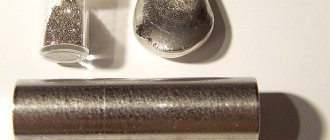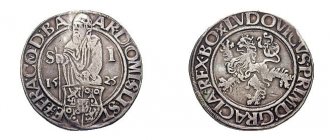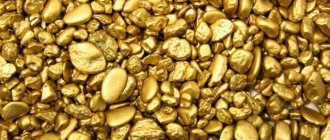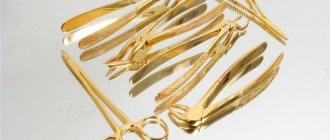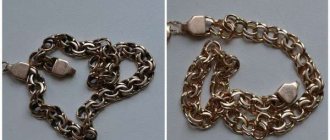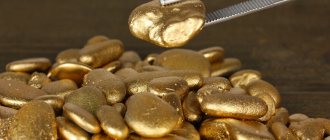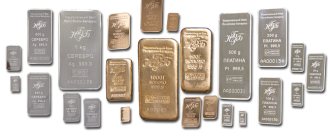History and origin
Translated from Greek, pyrite means “stone that creates fire.” It received this name for its ability to spark when struck. This useful feature placed the lighter mineral above gold.
Pyrite
The Incas of pre-Columbian America used a stone with shiny edges as a magic mirror; the Indians considered it an amulet against alligators.
Pyrite clouded the minds of the Spanish conquistadors: mistaking the mineral for gold, they took it from local residents by force or deception. And in their homeland they were made fools by showing off the pyrite gold of the Incas under the guise of a noble metal.
Prospectors from the Alaska Gold Rush were in trouble. Thus, the names “Inca gold” and “fool’s gold” were assigned to pyrite.
The mineral “golden” pyrite was exalted during the reign of Napoleon. It was awarded to ladies who donated jewelry to the fighting army. It was a badge of honor; patriotic French women were proud of such accessories.
The 20th century was a turning point for the mineral. British designers Butler and Wilson were visited by fresh ideas, their exclusive products became very popular and made the “golden” stone a favorite of bohemia.
Pyrite is formed as a result of magmatic or hydrothermal processes, at the bottom of closed sea basins, in the copper-nickel formation.
Igneous rocks are rich in small crystals; the largest cubes hide quartz veins.
Physicochemical characteristics
Pyrite is the most common sulfide. The crystal cubes have smooth edges and seem to have a hatched pattern on the surface.
| Formula | FeS2 |
| Color | Straw yellow, brass yellow, golden yellow, sometimes tarnished |
| Shine | Metal |
| Transparency | Opaque |
| Hardness | 6-6,5 |
| Cleavage | Very imperfect by {001} |
| Kink | Conchoidal |
| Density | 5.01 |
The hue and luster are visually identical to gold or silver, which once puzzled mineralogists. They spent a long time deciding whether it was stone or metal.
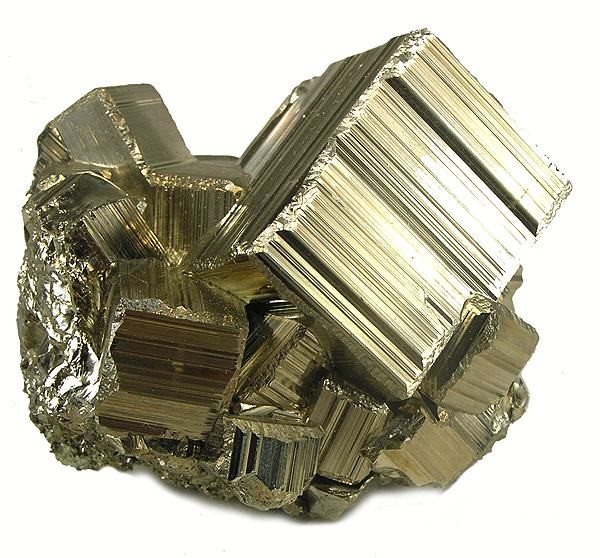
Pyrite stone
The dominance of sulfur and iron, as indicated by the chemical formula of the substance, led to other names for pyrite - sulfur pyrite and iron pyrite.
Some deposits
The maximum deposits of pyrite are located in the earth's crust. The most common hydrothermal mineral is sulfide. Significant amounts of pyrite were found in association with magnetite, chalcopyrite, and pyrrhotite.
The chemical formula of pyrite is FeS2. This substance is the starting material for the industrial production of sulfuric acid. The cinder formed after firing this mineral is a valuable product for the production of cast iron and steel.
The main deposits of pyrite in our country are found in Altai, the Caucasus, and the Urals. In Central Russia it is found in marine gray clays, as well as brown coal deposits.
Place of extraction
Pyrite is found almost everywhere on the planet. The largest deposits of the mineral are in Russia (Ural) and the USA. Small accumulations are found in Europe.
Specimens in condition suitable for processing and use are rare. Almost everything is supplied by Italy. In South Africa, material with uranium impurities is mined.
The shine of pyrite layers means the presence of gold nearby. This proximity makes the mineral look like a noble metal.
Pyrite can be found near hot springs. The stone is not mined separately, but is extracted from ore containing cobalt, zinc or copper.
Features of education
What is pyrite? The structural formula of this compound explains its igneous origin. It is released from hydrogen sulfide hot springs that come from magma chambers. Since the formula of pyrite is FeS2, it is found in fossil coals and sedimentary rocks. Significant accumulations of this mineral form on the ocean floor. This compound can be formed in many sedimentary rocks: marly, carbonaceous, clayey due to the reaction of a surface aqueous solution, which contains iron, with hydrogen sulfide obtained as the decomposition of organic residues.
What feature does the formula of the pyrite mineral have? In this compound, the ionic chemical bond predominates, giving the mineral strength and hardness. The compound is found at the bottom of lakes, swamps, and in metamorphic rocks.
Near the surface, pyrite is an unstable compound and is quickly subject to oxidation and chemical weathering. During oxidation, it transforms into limonite (insoluble iron hydroxide), as well as into a solution of sulfuric acid. For this reason, clusters of brown iron ore are often found in the upper layer of deposits of this mineral.
In mining areas, there are deposits of iron sulfide in the form of stalactites. In pyrite ores enriched with this mineral, native highly dispersed sulfur is formed.
In laboratory conditions, the pyrite formula can be obtained by reacting hydrogen sulfide with iron compounds. The reaction is carried out in an aqueous or alkaline solution.
Varieties and colors
Pure sulfur pyrite is rare. More often, impurities create a range of stones from barely noticeable yellowish to golden yellow.
Types of mineral:
- bravoite - thick yellowness comes from nickel (up to 20% of the composition), a jewelry variety;
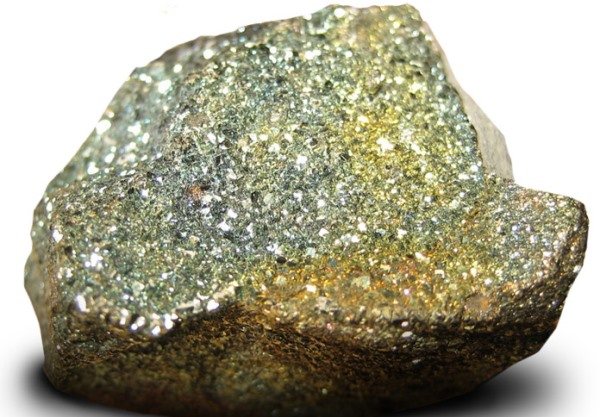
Bravoite mineral - marcasite - metallic shiny “drop silver” plus shimmer on a slightly yellowish background; It oxidizes easily, so it is not suitable for jewelry.
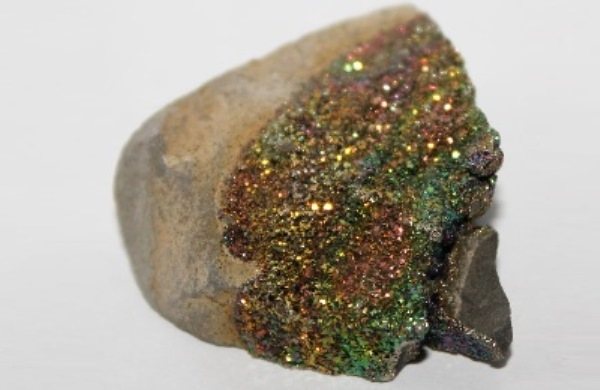
Mineral marcasite
Visual differences are created not only by impurities, but also by the lattice structure. Thus, marcasite is characterized by syngony, so the crystals resemble rays.
Features of pyrites
Pyrites are minerals that are selenium, arsenic, antimony, and selenium compounds of iron group metals. Among the representatives of this group we note: nickel, cobalt, platinum, iron. They have a characteristic metallic luster and are colored yellow, gray, and red. All pyrites have excellent hardness, but are considered brittle minerals.
These include systems of hexagonal and rhombic structure:
- regular systems, represented by pyrite, cobalt luster, speiss cobalt, ulmannite, chloanthite;
- Orthorhombic variants include arsenic pyrite and marcasite;
- Millerite, nickelite, magnetic pyrite have a hexagonal system;
- copper pyrite has a square shape.
Medicinal properties
The external resemblance to gold determined the healing properties of the stone.
Pyrite heals the soul and body, acting on a deep level. It cleanses and strengthens the human biofield, so even severe or chronic illnesses recede.
The mineral is applied to the problem area, from which it “pulls” bad energy. Helps with the following problems:
- infertility;
- infections, viruses;
- joint pain;
- skin fungus;
- freckles;
- cataract;
- decreased muscle tone.
By accelerating blood circulation, the stone stimulates the functioning of the cardiovascular system and lungs. Healers advise tying it to a woman’s leg to facilitate childbirth.
The mineral improves sleep and performance; it is suitable for people with a hectic pace of life or those engaged in routine hard work.
This is a natural antidepressant, but overly emotional people need to be careful with it.
Magic properties
Roman legionnaires and Greek warriors considered pyrite theirs. It was believed that this stone was the earthly embodiment of the god of war, Mars, and an amulet with it made the owner brave and protected from wounds.
The magical properties of the stone are also valued in the peaceful sphere. Sorcerers, psychics, and their other practicing colleagues do not skimp in order to take possession of an impeccable copy. Only a pebble with a smooth, solid surface, without chips or cracks, restores strength. Defective minerals attract problems.
Shiny pyrite crystals are powerful helpers for various purposes:
- peace of the family hearth, revival of marital feelings;
- success on the love front;
- eliminating conflicts at work and at home;
- protection from the elements;
- energy supply at the mental and physical levels;
- concentration for action in extreme situations.
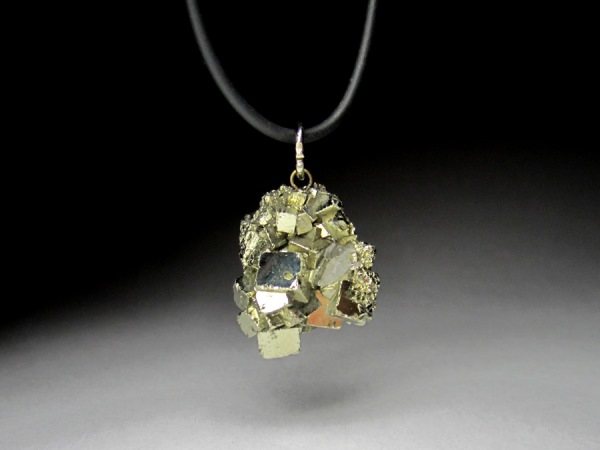
Pyrite cubes are talismans and amulets for people in risky professions: police officers, emergency workers, hot shop workers, firefighters, stuntmen. The owners of such a talisman become calmer and more resilient.
The stone is suitable for real and potential leaders.
However, this is a “highly moral” mineral; its magic only helps in actions with a plus sign. Liars, cunning people, dishonest people risk having the negative message sent back. In a favorable scenario, the value of the stone for them will be zero.
In what form does the mineral occur in nature?
In most ores and rocks, pyrite is found in the form of rounded grains or crystalline inclusions. Often there are solid aggregate masses, sometimes forming druses.
The most common are cubic or pentagondodecahedral/octahedral crystals. There are crystals whose dimensions reach several decimeters in cross section. They are characterized by hatched edges (the strokes form parallels with the edges of the cubes). Such stripes are always oriented perpendicular to adjacent faces, in accordance with the structural features of the mineral sample.
Often in nature, pyrite deposits grow together with tetrahedrites, marcasites, pyrrhotites and galenas. Pyrite crystals, formed under the influence of high or low temperatures, take the shape of an octahedron or cube. But the formation of simple forms under intermediate temperature conditions turns out to be an order of magnitude richer.
Pentagondodecahedral formations are considered typical of low-temperature, highly mineralized zones. But the pentagododecahedral habit is formed under conditions of intermediate temperatures. Cubic pyrite habitus is a typical example of formation at low supersaturation, and pentagondodecahedral - at high supersaturation, respectively.
Who is suitable according to their zodiac sign?
Energetically strong pyrite is patronized by the powerful Mars and Neptune. Not every zodiac sign can use the stone.
If a person’s work is monotonous or calm, but according to the horoscope there are no obstacles, moderate use of the stone is acceptable.
| Zodiac sign | Compatibility |
| Aries | +++ |
| Taurus | + |
| Twins | + |
| Cancer | — |
| a lion | +++ |
| Virgo | + |
| Scales | + |
| Scorpion | + |
| Sagittarius | +++ |
| Capricorn | + |
| Aquarius | + |
| Fish | + |
(“+++” – fits perfectly, “+” – can be worn, “-” – is strictly contraindicated)
Compatibility with other stones
Pyrite is a mineral of the fire element. Of the precious and semi-precious stones, only hematite and serpentine can be neighbors in jewelry or a box. The rest will be crushed by the powerful energy of the “golden” mineral.
For those who are indifferent to the magical properties of natural pyrite, jewelers offer multi-colored jewelry. In them, pyrite inserts or elements are aesthetically complemented with inexpensive gems: pressed turquoise, cultured pearls, garnet, jasper.
Application and Use
The physical properties of pyrite determined the areas of its use.
Industry
The main field of application of the stone. The mineral is used in the production of concrete, iron sulfate, cement, mastics, and steel.
Once upon a time, alchemists deceived powerful patrons with a “golden” stone. Modern adherents of this science are not interested in him. The idea of extracting gold from pyrite is utopian: it was found that there is as much of it as in the human body.
Jewelry
The material used in jewelry is structurally flawless and effective.
It is used to make pendants, necklaces, bracelets, and earrings for women. They are appropriate in the office, at a party or for a walk. The frames are bronze, brass, jewelry alloy and cupronickel.
Crystalline pyrite is a fertile material for men's assortment. A bracelet, pendant or pendant with minimal stone processing is truly brutal sophistication.
Collection material
Minerals with tarnish are prized by collectors. This is a real rainbow stone - it shimmers with all the colors of the solar spectrum. For example, copper impurities give a blue tint.
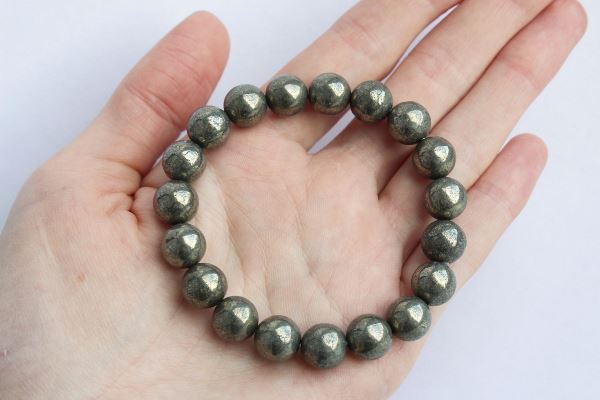
Pyrite bracelet
Yellow, green, brown fragments on the surface are the result of other elements in the composition of the mineral.
Price
Pyrite is inexpensive and is priced per gram or kilogram. The price of the product depends on the degree of processing:
- non-jewelry raw materials - $22–26 per kg;
- tumbling 12–45 mm – $40–45 per kg;
- beads about 40 cm long - $11 (2 mm), $8 (6 mm);
- figurine 15x8 cm - $200–250.
The ornamental mineral is difficult to process, so small beads are more expensive than large ones.
Characteristics of the mineral
According to the mineralogical classification, pyrite belongs to sulfide rocks; among its class, it is most widely found in the earth's interior. Layers of stone are found near deposits of pyrite or gold, as well as in the area of hydrothermal vents. Due to its high sulfur content, it is even sometimes called sulfur pyrite. The richest pyrite mines are developed in the Ural Mountains, Sweden, Norway, Spain, and Azerbaijan.
The mineral is fused crystals with smooth or rough edges of various shapes: cubes, octahedrons, dodecahedrons. There are specimens with crystals in the form of radial rays, spheres or hollow tubes. Pyrite inclusions or veinlets may be part of sedimentary rocks. There are two types of stone: silver marcasite and golden bravoite.
How to spot a fake
The cost of pyrite is affordable, but instead they offer plastic or glass with a shiny coating. In turn, the mineral is passed off as gold.
It is easy to distinguish pyrite from imitation:
- Evaluate for clarity. A real mineral is always impenetrable.
- Scratch the sample with your fingernail. Spraying on the imitation will do.
- Run the sample across the glass. Pyrite will scratch it without any problems.
To avoid buying a stone at the price of gold, just press on the surface or try on your tooth. Soft gold will leave a dent; hard pyrite does not have this property.
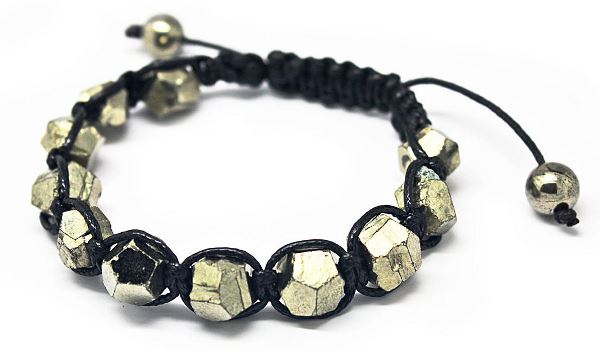
Shambhala made of pyrite
The characteristics of the mineral exclude fine processing. Jewelry made from pyrite is not elegant and filigree. They're rough, but they look great. This differentiates processed pyrite from gold or plastic.
How to wear and care
The energy of the stone is such that strong-willed people can constantly interact with it.
For the rest, esotericists recommend wearing jewelry for no more than three days in a row. Otherwise, a nervous breakdown, irritability, even insanity are guaranteed.
The mineral is delicate; the following are contraindicated:
- falls, mechanical impacts;
- prolonged exposure to the sun;
- household chemicals;
- proximity to other stones.
Even ordinary conditions are not suitable: within a few years, untreated pyrite crumbles in air. This is probably where the legends about old pirate treasures that became dust came from. The earth or deep sea destroys the mineral faster.
For safety, experts recommend covering dry items or crystals in jewelry that are free of oxides and dirt with colorless nail polish or soaking them in vegetable oil. Owners of pyrite items say that in this form they retain their original appearance and last for many years
.
Caring for collectible exhibits is troublesome. Oxygen in the air decomposes the mineral, and water that gets on the stone creates sulfuric acid, which is destructive to the exhibit.
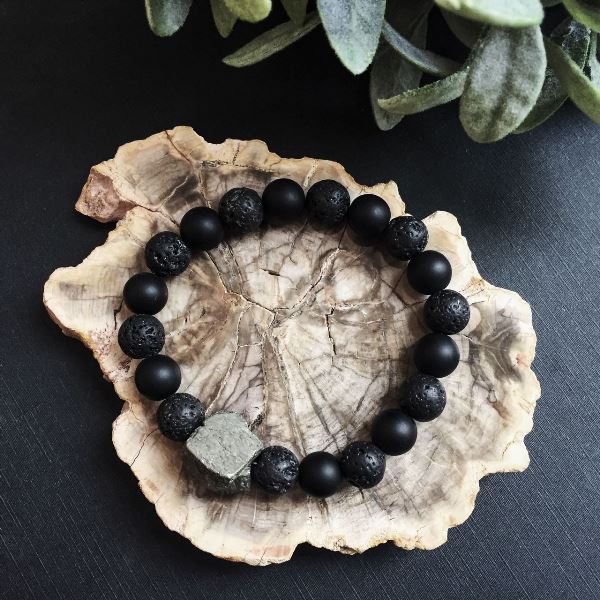
Pyrite bracelet
Therefore, it is better to store fossils with pyrite in vacuum packaging. It's expensive and not available to everyone. It is cheaper, following the example of museum workers, to boil it over low heat in paraffin or rosin. The procedure can be done at home, but only a vacuum provides a complete guarantee of the safety of structurally heterogeneous samples.
Physical Features
The mineral occurs in the form of druses or granular solid masses. Drusen are an aggregate of crystals that have grown on a common base. They are found on the walls of open cracks.
Secretions are the form of mineral deposits within rocks. The growth of minerals is observed towards the center from the edges. Geodes are secretions that are about two centimeters in diameter.
Pyrite is characterized by crystals of octahedral, cubic, and also pentagondodecahedral shape. The density of the mineral is 5 g/cm3. The pure compound, free of impurities, contains 46.7 percent iron and 53.3 percent sulfur. The brass-yellow color characteristic of pyrite, the metallic luster, visually turns pyrite into gold. Under conditions of high humidity, pyrite decomposes, forming iron oxides, sulfuric acid, and sulfates. It burns in air with a bluish flame, and a characteristic sulfuric odor is felt.
